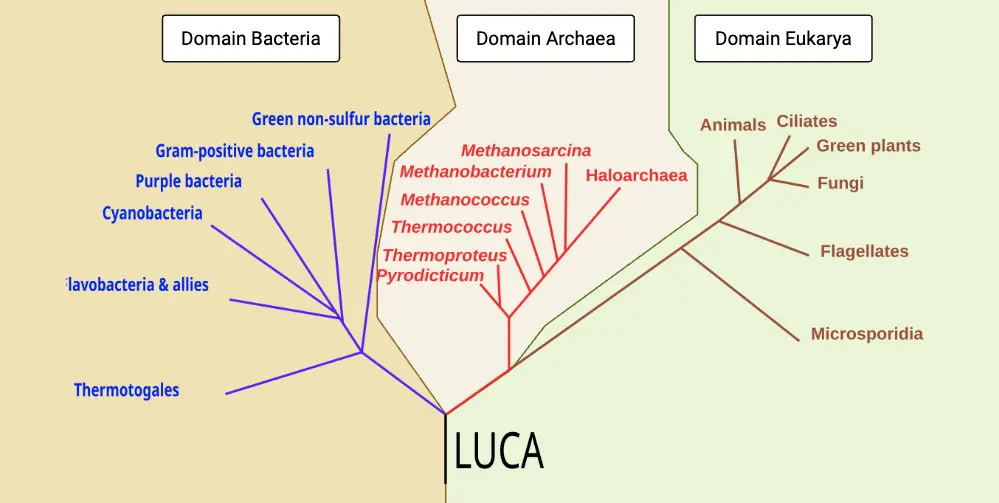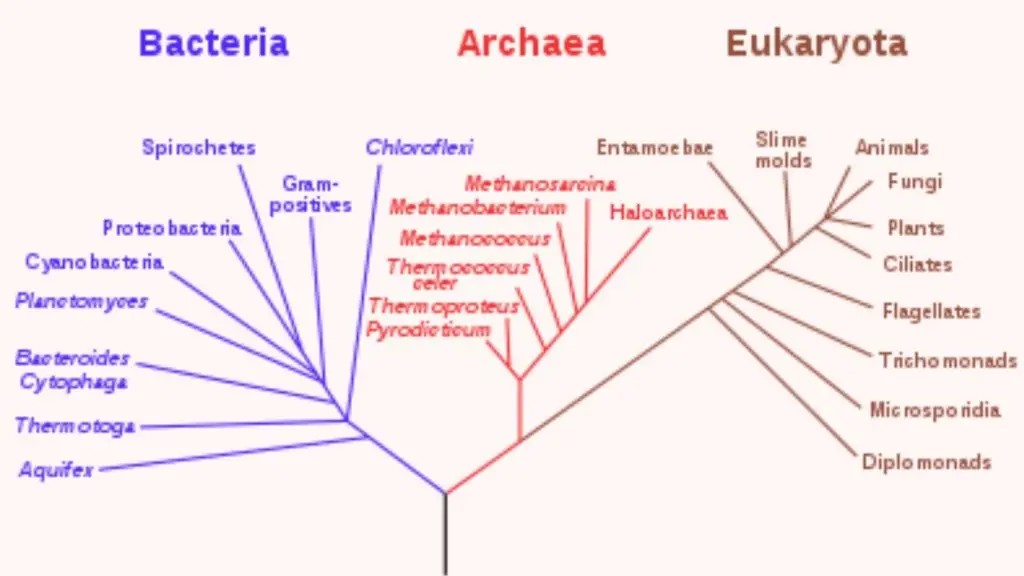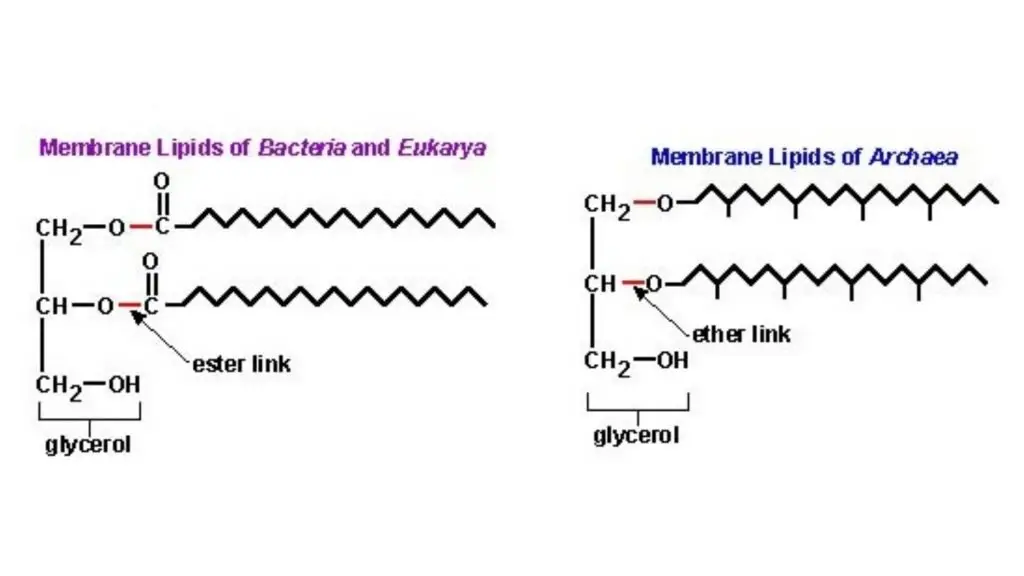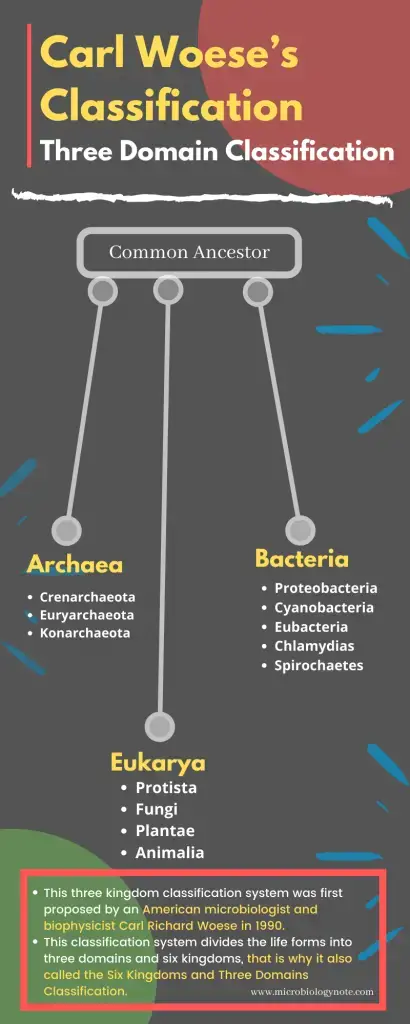All living organisms are grouped into three major categories under the three-domain system, a modern way to classify life based on genetic and evolutionary relationships. Proposed by microbiologist Carl Woese in the 1990s, this system splits life into Bacteria, Archaea, and Eukarya. Bacteria are the familiar single-celled microbes found everywhere, from soil to our bodies, lacking a cell nucleus. Archaea, though similar in size to bacteria, have unique genetic traits and often live in extreme environments like hot springs or deep-sea vents. Eukarya includes all organisms with complex cells containing nuclei, like animals, plants, fungi, and protists. This model highlights how ancient evolutionary splits shaped life’s diversity, moving beyond older systems that lumped simple organisms together. By focusing on DNA similarities, it reshaped how scientists understand life’s family tree.

What is three domain system?
- Carl Woese Otto Kandler and Mark Wheelis first proposed the three-domain approach as a taxonomic framework for classifying all cellular life into the categories Archaea, Bacteria, and Eukarya in 1990.
- Comparative examination of ribosomal RNA sequences reveals basic evolutionary differences among species, therefore guiding the system.
- Woese and Fox’s 1977 suggestion identifying Archaea then known as Archaebacteria as different from Bacteria based on 16S rRNA marks the fundamental historical turning point leading to the three-domain approach.
- Originally used explicitly in the 1990 Proceedings of the National Academy of Sciences study suggesting domains atop kingdoms to represent major lines of ancestry, the word domain was
- Emphasising molecular phylogeny over morphological features and changing the Tree of Life, the three-domain categorisation transformed biology.
- The method emphasises that while being prokaryotic, Archaea have more genetic resemblance with Eukarya than with Bacteria.
- The three domains identify themselves as follows.
- Prokaryotic creatures lacking a nuclear membrane with special membrane lipids, Archaea flourish in harsh conditions like hot springs and salt lakes.
- Prokaryotic organisms with peptidoglycan cell walls and varied metabolic capacity—both harmful and beneficial—such as gut flora—bacteria
- Eukarya include all creatures including mammals, plants, fungi, and protists with membrane bound nuclei and organelles.
- Comparatively slow evolution of 16S and 18S rRNA sequences provides dependable phylogenetic signals, hence forming the methodological basis.
- Although the three-domain theory is still extensively utilised, various theories such the two-domain system suggesting eukaryotes arising from inside Archaea have challenged it.
- Studies in microbiology, ecology, evolutionary biology, and biotechnology depend on an awareness of the three-domain system as it shapes the genetic variety of life and the evolutionary links.
What are main basis of Carl Woese’s Classification
- Carl Woese’s classification, recognised as the Three-Domain System, was introduced in 1990 and transformed biological taxonomy by organising life into three domains: Bacteria, Archaea, and Eukarya.
- This classification was fundamentally grounded in the comparative analysis of 16S ribosomal RNA (rRNA) sequences, offering valuable insights into the evolutionary relationships among various organisms.
- Woese’s investigation uncovered that Archaea, once categorised alongside Bacteria, exhibit unique genetic and biochemical traits, justifying their designation as a distinct domain.
- This system prioritised genetic characteristics rather than phenotypic traits, providing a more precise depiction of phylogenetic relationships among organisms.
- The Three-Domain System is broadly recognised within the scientific community and has profoundly impacted our comprehension of the evolutionary history and diversity of life.
The three domain system – Carl Woese’s Classification

Carl Woese’s Classification three domains are as follows:
- Archaea: Prokaryotic organisms lacking a nuclear membrane, possessing unique membrane lipids, and often thriving in extreme environments such as hot springs and salt lakes.
- Bacteria: Prokaryotic organisms characterized by peptidoglycan cell walls and diverse metabolic capabilities, including both beneficial (e.g., gut microbiota) and pathogenic species.
- Eukarya: Organisms with membrane-bound nuclei and organelles, encompassing animals, plants, fungi, and protists.
1. Domain Archaea
- Along with Bacteria and Eukarya, Archaea make up one of the three domains of life as determined by Carl Woese and associates in 1990. ‘
- Lacking a membrane-bound nucleus and organelles, archaea are prokaryotic, single-celled creatures. They have different genetic and metabolic traits even if their structure is like that of bacteria.
- Archaea define themselves in part by their distinct cell membrane composition. Archaeal membranes differ from those of bacteria and eukaryotes, which contain ester-linked phospholipids in that they feature ether-linked lipids. This structural variation improves membrane stability, which lets archaea flourish in hostile conditions.
- Archaea have different cell walls than bacterial ones. Archaeal cell walls lack peptidoglycan but bacterial cell walls have this element. Rather, many archaea have S-layer made of proteins or glycoproteins, which offers structural support and defence.
- Archaeas have several metabolic routes. Especially, a metabolic process exclusive to certain archaea is methanogenesis, the synthesis of methane. Absence in bacteria and eukaryotes, this mechanism is fundamental in carbon cycle.
- Archaea were formerly believed to live in just severe conditions, such salt lakes and hot springs. Subsequent studies, however, have shown their prevalence in a variety of ecosystems including seas, soils, and the human microbiome.
- Particularly in terms of transcription and translation, genetically archaea resemble eukaryotes. Archaeal RNA polymerases and ribosomal proteins, for example, more closely reflect those seen in eukaryotic cells than those in bacterial cells.
- By means of binary fission, fragmentation, or budding, Archaea asexually reproduce. Archaea lack endospores unlike certain bacteria.
- Regarding ecological responsibilities, archaea engage in symbiotic interactions in many different environments and help nitrogen and carbon cycles to be cycled.
- Archaea have highlighted their importance in both harsh and moderate settings, therefore broadening our knowledge of microbial diversity and evolution.
Three phyla of Domain Archaea
Several phyla make up the domain Archaea; three important ones are Crenarchaeota, Euryarchaeota, and Korarchaeota. Genetic, metabolic, and ecological traits help to define these groupings.
- Creensaeota
- Mostly thermophiles, members of this phylum flourish in high-temperature habitats like hydrothermal vents and hot springs.
- Their special lipid membranes made of ether-linked lipids give stability under very demanding situations.
- According to genomic studies, Crenarchaeota are quite important in carbon and nitrogen cycling in many environments.
- Earyarchaeota
- Included in this varied phylum are thermophiles, halophiles, and methanogens.
- Found in anaerobic habitats such as wetlands and ruminant digestive systems, methane is a metabolic byproduct produced by methanogens.
- Halophiles have evolved to withstand osmotic stress using specialised ion pumps and suitable solutes; they live in very saline habitats like salt lakes and salt mines.
- Extremely heated conditions allow Thermophilic Euryarchaeota to persist, which helps organic matter break down rapidly at high temperatures.
- Korarchaeota
- Less well known phylum, Korarchaeota are mostly found via environmental DNA sequencing.
- Usually found in high-temperature settings, including as springs, they are thought to be an old Archaea lineage.
- Based on sparse genomic evidence, Korarchaeota seem to have a combination of traits seen in both Crenarchaeota and Euryarchaeota, suggesting a perhaps critical role in archaeal evolution.

2. Domain Bacteria
- Along with Archaea and Eukarya, Carl Woese’s 1990 definition of three major domains of life identifies Domain Bacteria.
- As prokaryotic microbes, bacteria lack additional membrane-bound organelles and a nucleus bound by membrane.
- Found almost everywhere on Earth, from soil to water to acidic hot springs to radioactive waste to the deep biosphere of Earth’s crust, they are unicellular creatures.
- By fixing nitrogen from the atmosphere and recycling nutrients, bacteria are indispensible in many phases of the nutrient cycle.
- They also participate in the putrefaction, or breakdown, of dead corpses.
- Extremophile bacteria transform dissolved molecules such hydrogen sulphide and methane into energy in biological communities around hydrothermal vents and cold seeps.
- Living in mutualistic, commensal, and parasitic interactions with plants and animals are bacteria.
- Although around 43,000 kinds of bacteria have been identified, many have not been investigated closely.
- Branch of microbiology, bacteriology is the study of bacteria.
- Different criteria—cell shape, metabolism, and genetic variations—help to classify bacteria.
- The Gramme stain is a standard technique of classification that separates bacteria according to structural traits of their cell walls. ,
- Furthermore useful for classification are bacterial staining properties, shape, and growth patterns.
- Categorising and identifying microorganisms is increasingly done using molecular methods like DNA sequencing.
- From the fermentation of cheese and yoghurt to the recovery of metals in mining (biomining), and the synthesis of antibiotics and other compounds, bacteria are indispensible in many different industrial uses.
- They are also vital in the breakdown of oil spills and sewage treatment.
- While many bacteria are benign or helpful, certain species are harmful and can lead to illnesses like cholera, syphilis, anthrax, lepra, TB, tetanus, and bubonic plague.
- Although bacterial infections are treated with antibiotics, overuse and abuse of these medications have produced antibiotic-resistant bacteria, a rising public health issue.
- In biotechnology, bacteria are also utilised for purposes like genetic engineering, in which case they can be altered to generate drugs like insulin or to clean up environmental toxins.
- In both natural and applied sciences, bacteria—despite their small scale—have a major influence on the environment, human health, and many sectors, therefore stressing their relevance.
Phyla of the bacterial domain
A very large group of prokaryotic species are included in the category Bacteria. There are many groups of bacteria, but five stand out because of their roles in the environment and in human health:
- The proteobacteria
- The family Proteobacteria is one of the largest groups of Gram-negative bacteria. It is home to many diseases, such as Escherichia coli, Salmonella, Vibrio, and Helicobacter.
- Phototrophy, chemolithotrophy, and heterotrophy are some of the metabolic methods that members use.
- Alpha-, Beta-, Gamma-, Delta-, and Epsilonproteobacteria are the groups that make up this order.
- Strongholds
- Firmicutes are made up of mostly Gram-positive bacteria with low G+C content in their DNA. Genera like Bacillus, Clostridium, Lactobacillus, and Staphylococcus are part of this group.
- Many species can make endospores, which help them stay alive in harsh environments.
- They are important for both health and sickness and play key roles in fermentation processes.
- Actinobacteria
- This group is made up of Gram-positive bacteria that have a lot of G+C.
- Some well-known members are Streptomyces, which makes antibiotics, and Mycobacterium, which has diseases like M. tuberculosis.
- It is common for actinobacteria to live in dirt environments and help break down organic matter.
- Bacteroidetes
- Bacteroidetes are Gram-negative bacteria that don’t make spores. They are usually found in the guts of animals, including people.
- They play a big role in breaking down complex sugars, which makes metabolism easier.
- Some species can cause disease when they have the chance, especially in people who don’t have strong immune systems.
- The cyanobacteria
- Cyanobacteria are photosynthetic bacteria that can do oxygenic photosynthesis. They are also called blue-green algae.
- They were very important to Earth’s past because they helped add oxygen to the air.
- Cyanobacteria can be found in many types of water settings and can sometimes grow in large numbers to cause dangerous algal blooms.
3. Domain Eukarya
The domain Eukarya includes all organisms that possess eukaryotic cells, which are defined by their membrane-bound nucleus and intricate organelles. This domain encompasses a diverse array of organisms, including both unicellular and multicellular forms, spanning from tiny protists to sizable animals and plants. Eukaryotic cells demonstrate compartmentalisation, which facilitates specialised functions within various organelles, including mitochondria, endoplasmic reticulum, and Golgi apparatus.
Eukaryotic organisms engage in reproduction via both asexual and sexual methods, utilising mitosis and meiosis, respectively. The genetic material is structured into linear chromosomes contained within the nucleus, and it frequently exhibits intricate life cycles and developmental phases.
In the Domain Eukarya, organisms are categorised into various kingdoms according to their characteristics, including cell structure, nutritional methods, and reproductive strategies. The main kingdoms consist of:
- Kingdom Protista (Protoctista)
- Includes a varied collection of primarily unicellular organisms, although a few are multicellular.
- Demonstrates different nutritional strategies: autotrophic (such as algae), heterotrophic (like protozoa), or mixotrophic.
- Reproduces through asexual means and, in certain instances, through sexual methods.
- Comprises entities like amoebae, paramecia, and specific types of algae.
- Fungi Kingdom
- Includes both unicellular organisms, such as yeasts, and multicellular organisms, like moulds and mushrooms.
- Chitin is a component found in cell walls.
- Organisms that obtain their nutrients from organic materials, frequently by means of decomposition.
- Reproduces through spores, utilising both sexual and asexual methods.
- Kingdom Plantae
- Kingdom Plantae encompasses a diverse range of organisms that are primarily characterised by their ability to perform photosynthesis, contributing significantly to the Earth’s ecosystems and providing essential resources for various life forms.
- Organisms that are multicellular and primarily capable of autotrophy, utilising chlorophyll to carry out the process of photosynthesis.
- Cell walls are made up of cellulose.
- Demonstrates a shift between different generations throughout their life cycles.
- This encompasses mosses, ferns, conifers, and flowering plants.
- Animal Kingdom
- Organisms composed of multiple cells that obtain their nutrition by consuming food.
- Absence of cell walls.
- Demonstrate distinct tissues and organs.
- Reproduce mainly through sexual means, involving intricate developmental phases.
- Covers a wide range of organisms, spanning from sponges to mammals.
The classification within Domain Eukarya illustrates the evolutionary connections and functional adaptations of organisms, offering a framework for comprehending the complexity and diversity of life forms.
Why is rRNA a good ‘Chronometer’? – Why Carl Woese used rRNA for his classification?
Ribosomal RNA (rRNA), especially the 16S rRNA gene in prokaryotes and the 18S rRNA gene in eukaryotes, is considered a valuable tool for reconstructing evolutionary relationships and estimating divergence times among organisms.
The effectiveness of rRNA as a molecular chronometer can be linked to several important features:
- Universality – rRNA genes are found in every living organism, rendering them perfect for comparative studies among various taxa.
- Conserved and Variable Regions – rRNA molecules feature highly conserved regions that aid in aligning sequences from distantly related organisms, alongside variable regions that offer the necessary resolution to differentiate closely related species.
- Functional Constraints – The critical importance of rRNA in the process of protein synthesis establishes significant functional constraints, resulting in a comparatively gradual and consistent pace of evolutionary change. This stability improves its dependability as a molecular clock.
- Low Horizontal Gene Transfer – rRNA genes exhibit a reduced susceptibility to horizontal gene transfer in comparison to other genes, thereby maintaining the vertical inheritance patterns essential for precise phylogenetic analyses.
The combination of these attributes renders rRNA, particularly the 16S rRNA gene, an essential resource for molecular systematics, enabling the inference of evolutionary relationships and providing more reliable estimates of divergence times.
Domains of Carl Woese’s Classification

Importance of Three-domain system
- The three-domain system established a systematic, sequence-oriented approach for categorising all cellular life through the comparison of ribosomal RNA sequences, moving away from the reliance on subjective morphological characteristics.
- The findings indicate that Archaea constitute a lineage that is as separate from Bacteria as either is from Eukarya, challenging the previously accepted notion of a singular prokaryotic group and transforming microbial taxonomy.
- This established rRNA—specifically the 16S and 18S genes—as a universal molecular chronometer, found in all organisms and evolving under significant functional constraints, allowing for dependable estimates of evolutionary divergence.
- The Tree of Life was restructured into three main branches—Bacteria, Archaea, and Eukarya—revealing profound evolutionary divisions that morphology-based systems had previously overlooked.
- The phylogenetic scaffold established a foundation for contemporary microbial ecology, enabling the discovery and classification of uncultured microorganisms via environmental rRNA surveys.
- This approach facilitated metagenomic studies by employing rRNA as a barcode to characterise complete microbial communities directly from environmental samples, eliminating cultivation bias.
- The emergence of molecular systematics was catalysed, showcasing that gene-sequence data produce more precise evolutionary trees and leading to advancements like the developing two-domain hypothesis.
- The findings highlighted that the predominant genetic and metabolic diversity is found within microbial domains (Bacteria and Archaea), as opposed to multicellular eukaryotes.
- The findings shed light on the characteristics of the Last Universal Common Ancestor (LUCA) and the initial divergence of cellular life, establishing a timeline for the emergence of significant life forms.
- The findings significantly influenced biotechnology by recognising extremophilic archaea as valuable sources of thermostable enzymes and innovative biomolecules for use in industrial and medical fields.
- The initiative prompted updates to biology curricula and textbooks globally, guaranteeing that students are educated in a classification system that is evolutionarily sound and based on molecular data.
- This sparked essential discussions regarding the essence of biological classification, questioning Linnaean structures and encouraging innovative theoretical frameworks in evolutionary biology.
- This established a foundation for the fields of comparative and evolutionary genomics, facilitating extensive investigations into the origins of genes, horizontal gene transfer, and the development of cellular complexity.
- This ongoing inquiry enhances our understanding of astrobiology by directing the exploration for extraterrestrial life towards conserved molecular signatures and possible extremophile counterparts of primitive Earth organisms.
Limitations of Three-domain system – Horizontal Gene Transfer (HGT) Complications
The phenomenon of horizontal gene transfer, involving the exchange of genetic material between organisms outside of conventional reproductive methods, complicates the distinctions between biological domains, thereby questioning the precision of the three-domain classification system.
- Excessive Focus on rRNA Gene Trees – Dependence on 16S rRNA gene sequences may not provide an accurate representation of the phylogenetic relationships among all organisms, as these gene trees may not correspond with the phylogeny of the organisms themselves.
- Discussion on the Eocyte Hypothesis – The Eocyte Hypothesis posits that Eukarya emerged from within the Archaea domain, indicating a two-domain system instead of three.
- Ambiguities in Protist Phylogeny – The classification of protists is a subject of ongoing debate, with certain studies suggesting that they do not constitute a monophyletic group within the Eukarya domain.
- Inconsistent Phylogenetic Results – Various molecular markers can produce inconsistent phylogenetic trees, resulting in differences in the classification of specific organisms.
- Absence of Distinct Domain Boundaries – The boundaries between domains are often ambiguous, with certain organisms displaying traits that bridge these categories, thereby complicating the classification process.
- Risk of Excessive Simplification– The three-domain system could potentially simplify the intricate nature of life’s evolutionary history, possibly missing important divergences within the domains.
Difference between three domain system and five kingdom system
| Feature | Three-domain system | Five-kingdom system |
|---|---|---|
| Introduced by (year) | Carl Woese, Otto Kandler & Mark Wheelis (1990) | Robert Whittaker (1969) |
| Taxonomic rank | Domain above kingdom level | Kingdom as highest rank (below domain in later systems) |
| Number of principal categories | Three domains | Five kingdoms |
| Basis of classification | Comparative 16S/18S rRNA sequence analysis | Morphology, nutrition mode, cell structure and ecological roles |
| Major groups recognized | Bacteria; Archaea; Eukarya | Monera (Prokaryotae); Protista; Fungi; Plantae; Animalia |
| Treatment of prokaryotes | Splits prokaryotes into Bacteria and Archaea | Groups all prokaryotes into Monera kingdom |
| Emphasis | Molecular phylogeny and evolutionary lineage depth | Phenotypic traits and ecological function |
| Resolution of evolutionary relationships | High, due to conserved rRNA chronometer | Lower, subject to convergent morphology |
| Criticisms | Lateral gene transfer complicates lineage tracing | Does not account for molecular divergence, mixes unrelated lineages |
| Current status | Widely adopted; some debate over two-domain vs three-domain | Largely supplanted by domain system, but retained in teaching contexts |
| Impact on education | Revised textbooks to include domains and molecular approach | Historically foundational; now taught as precursor to domains |
Quiz
What is Carl Woese best known for in the field of microbiology?
a) Discovering the structure of DNA
b) Proposing the Three-domain system of classification
c) Identifying the first antibiotic
d) Studying the human microbiome
Before Carl Woese’s classification, how many primary kingdoms of life were recognized?
a) Two
b) Three
c) Five
d) Six
Which of the following is NOT one of the domains proposed by Carl Woese?
a) Eukarya
b) Bacteria
c) Protista
d) Archaea
Carl Woese’s classification system was primarily based on differences in which molecular structure?
a) DNA
b) Proteins
c) 16S ribosomal RNA (rRNA)
d) Lipids
In which year did Carl Woese introduce the Three-domain system?
a) 1977
b) 1980
c) 1990
d) 2000
Which domain contains organisms that are considered extremophiles and have unique membrane lipids?
a) Bacteria
b) Eukarya
c) Protista
d) Archaea
Which domain, according to Carl Woese’s Classification, includes multicellular organisms like plants and animals?
a) Bacteria
b) Eukarya
c) Archaea
d) Protista
Carl Woese’s classification system emphasized the importance of which type of evolutionary relationship?
a) Convergent evolution
b) Divergent evolution
c) Phylogeny
d) Co-evolution
Which domain, as per Carl Woese’s Classification, primarily consists of prokaryotic cells without a membrane-bound nucleus?
a) Eukarya
b) Protista
c) Archaea
d) Animalia
What was the primary tool used by Carl Woese to differentiate between the domains?
a) Microscopy
b) Biochemical tests
c) Comparative analysis of 16S rRNA sequences
d) Genetic mapping
FAQ on Carl Woese’s Classification
Q1. Explain why a two three and five Kingdom system is no longer acceptable for classification?
Before 1969, there was two-kingdom classification, in which life was divided into two kingdoms such as, Animal Kingdom and the Plant Kingdom.
The two-kingdom classification system did not last too long because this two-kingdom classification can not differentiate between the eukaryotes and prokaryotes; neither unicellular and multicellular; nor photosynthetic and the non-photosynthetic.
Between 1969 – 1990 the five-kingdom classification system was introduced. In this classification system life was divided into five-kingdom such as Monera, Protista, Plantae, Fungi, Animalia. This classification system divides the life based on their anatomy, morphology, embryology, and cell structure.
There were several limitations of five kingdom classification such as this classification system does not mention about viruses, even this classification does not mention about how organisms within Kingdoms or between kingdoms may be related to each other via evolutionary relationships among the kingdoms.
After 1990, The Domain kingdom classification system or Carl Woese’s Classification or Six Kingdoms and Three Domains Classification was introduced. This classification system is based on the genetic characteristics (rather than phenotypic ones) with respect to evolutionary relatedness (phylogeny) of organisms that may prove more stable and predictable.
There were several limitations or drawbacks of these classifications that is why they don’t last too long. (Follow my previous articles )
Q2. What are the 3 domains of classification?
The three domains of Carl Woese’s Classification are the Archaea, the Bacteria, and the Eukarya.
Q3. How are the 3 domains of life related?
Three domains of living things, archaea, bacteria, and eukarya, are organized by shared characteristics fundamental to life: cellular organization, biochemistry, and molecular biology.
Q4. What are the 3 domains and 6 kingdoms?
The three domains are archaea, bacteria, eukaryote, and six kingdoms are Archaebacteria (ancient bacteria), Eubacteria (true bacteria), Protista, Fungi, Plantae, Animalia.
References
- https://www.biologydiscussion.com/organism/notes-on-carl-woeses-concept/54699
- https://www.biology.iupui.edu/biocourses/N100/2k23domain.html
- https://bio.libretexts.org/Bookshelves/Microbiology/
- https://en.wikipedia.org/wiki/Three-domain_system
- https://paleontology.fandom.com/wiki/Three-domain_system
- https://www.thoughtco.com/three-domain-system-373413
- Text Highlighting: Select any text in the post content to highlight it
- Text Annotation: Select text and add comments with annotations
- Comment Management: Edit or delete your own comments
- Highlight Management: Remove your own highlights
How to use: Simply select any text in the post content above, and you'll see annotation options. Login here or create an account to get started.